The Angelbird Wings PX1 M.2 Adapter Review: Do M.2 SSDs Need Heatsinks?
by Billy Tallis on December 21, 2015 8:00 AM ESTSequential Write
Sequential writes are easier for the SSD controller to process than random writes, so throughput is almost always higher and the bottleneck in this test shifts more to the flash itself. This test puts the most intense load on the flash out of any of our tests, and usually produces the highest overall power consumption. The timing of the sub-tests is the same as for the random tests, and the drive is filled before the test so that features like SLC write caching don't distort the beginning of the test.
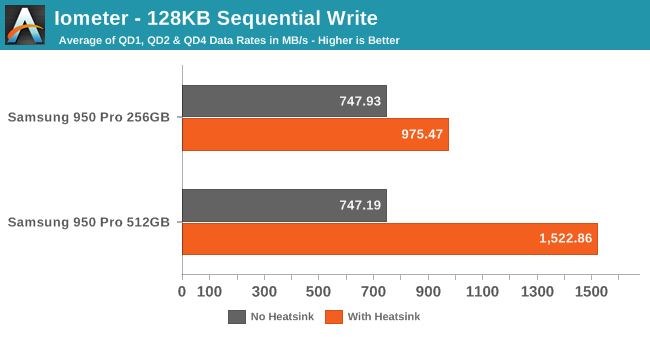
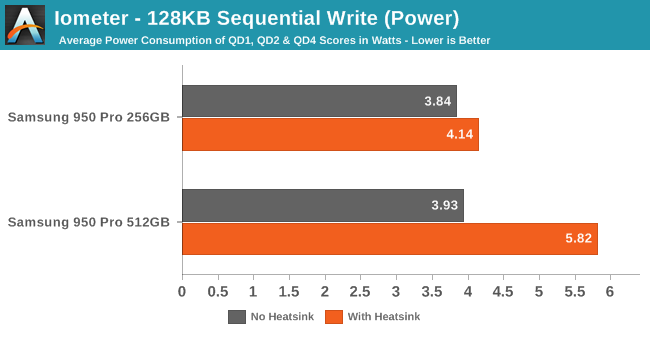
The heatsink provides a nice boost to the 256GB 950 Pro's sequential write speed, but doubles the sustained performance of the 512GB model. Power efficiency is still improved, especially for the 512GB drive, but it's now reaching almost 6W.
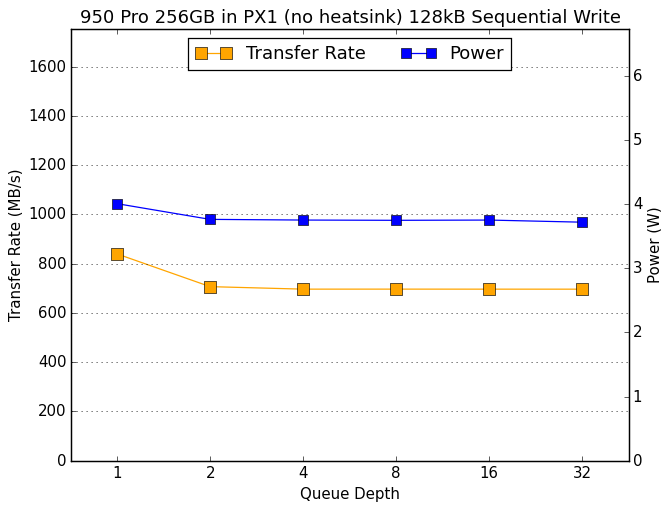 |
|||||||||
| 256GB no heatsink | 512GB no heatsink | ||||||||
| 256GB with heatsink | 512GB with heatsink | ||||||||
Without the heatsink, both drives experience thermal throttling only a few minutes into the test, with QD2 performance lower than QD1. With the heatsink, both drives show steady performance across the entire test. The 256GB improves QD1 performance slightly while the 512GB drive sees a 73% increase in QD1 performance. At queue depths greater than one the performance improvements are even larger.
Sequential Read
With the lower overhead of sequential operations and the inherent speed advantage reads have over writes, the sequential read test usually produces the highest throughput numbers. For SATA drives nowadays this usually means the SATA interface itself is the bottleneck, but even with NVMe we haven't seen a drive yet saturate the bandwidth of a PCIe 3.0 x4 link. Depending on the drive, this test could be limited by bottlenecks in the SSD controller's host interface or its connections to the flash memory.
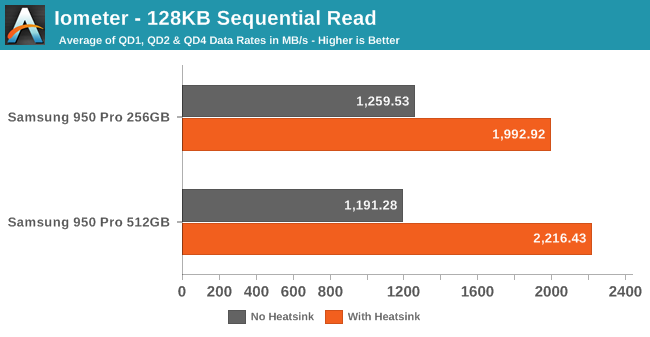

Both capacities see significant gains in sequential read performance, accompanied by smaller but still significant increases in power consumption. The 512GB drive once again manages to double sustained performance, and the 256GB improves by 58%.
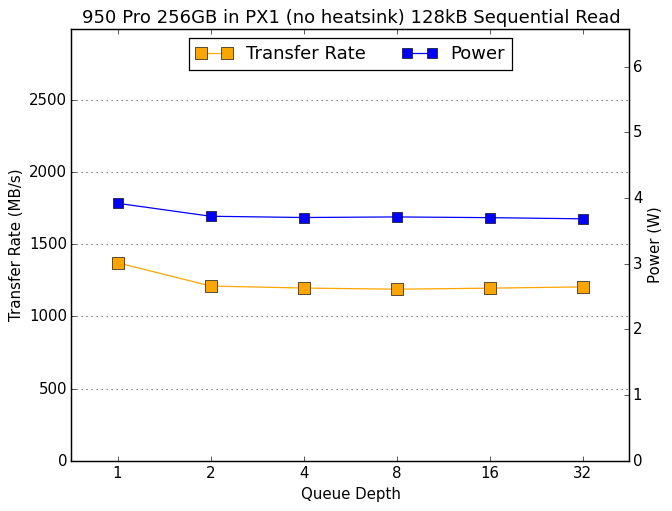 |
|||||||||
| 256GB no heatsink | 512GB no heatsink | ||||||||
| 256GB with heatsink | 512GB with heatsink | ||||||||
Again we see that the drives can't scale with higher queue depths when they're thermally constrained, but when properly cooled they perform superbly with any queue depth larger than one. The 512GB drive manages to deliver slightly more than 2.6GB/s read speed, well above what can be achieved with PCIe 2.0 x4 and about two thirds of the capacity of the PCIe 3.0 x4 link used by the 950 Pro.










69 Comments
View All Comments
edzieba - Tuesday, December 22, 2015 - link
With most Skylake ITX boards having the m.2 slot on the back, it would be interesting to see how well a simple coupling of the drive to the motherboard backplate with an adhesive thermal pad compares to the bare drive (and/or to a dedicated PCIe slot heatsink like this). I suspect the relatively tiny power levels involved (barely over 5W at most) would mean a nice sheet of aluminium or steel would be more than enough heatsinking for even sustained heavy loads.zodiacfml - Tuesday, December 22, 2015 - link
Performance of these drives are awesome that I would never be able to throttle them even if I try. Regarding the form factor, I believe they have designed it really well. It might be too big in 5 to years from now.fvbounty - Tuesday, December 22, 2015 - link
Can you post some temps, I'm surprised you didn't have them in the review?kilgor270 - Friday, January 1, 2016 - link
Just installed my PX1 with a Samsung SM951 as my boot drive. The PX1 seems to be very well constructed in my opinion. Easy to put the SM951 chip in and then install into computer.The white LED's were a surprise. Since I'm not a gamer, to me the leds are just an indication that power is going to the board. I monitored the heat using a couple software apps and at first glance without stressing it, it is hovering around 90 degrees F. Performance r/w is right around 1450 MBs +/-Overall for a couple days testing, I am very very happy with this combination as a boot drive. Totally changed my overall system profile in a very positive way.
orencom - Thursday, January 7, 2016 - link
the real question is weather there are real use cases which utilize PCIe SSD bandwidth capabilities...Machou360 - Sunday, January 10, 2016 - link
Just bought two of these and in RAID0, they are a beast ! Made the same bentches and putting a raspberry heatsink on each of the M2 controller simply avoids any heat issue (had to remote part of the sticker for that, which was very easy) I would recommend these drives anytime, performance is superb!XmppTextingBloodsport - Saturday, March 19, 2016 - link
"Will thrashing air about be efficacious?""Should we really rely upon [haphazard] fans for cooling?"
jefflynn333 - Sunday, September 4, 2016 - link
I would like to see the Angelbird tested against just using small heat sinks attached to the 950. That seems like a logical alternative.